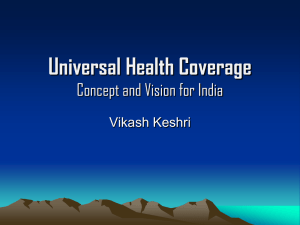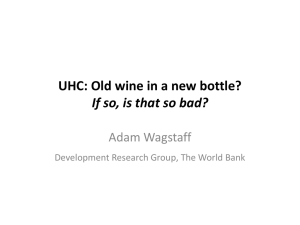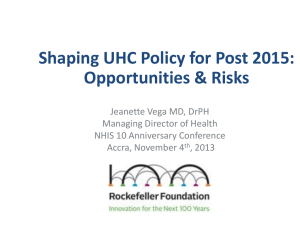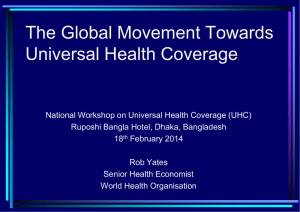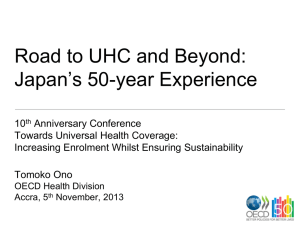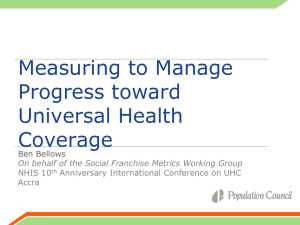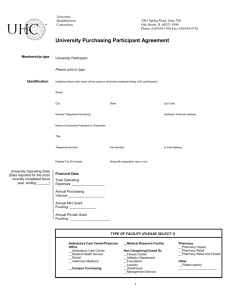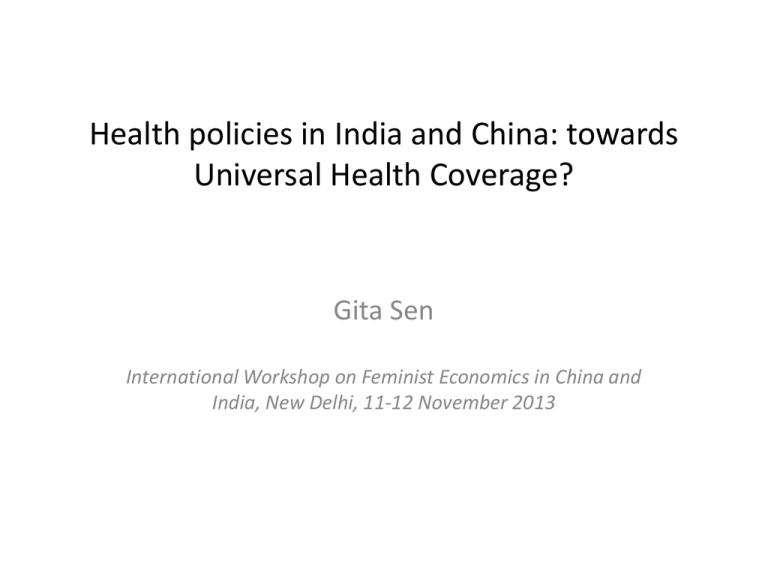
Health policies in India and China: towards
Universal Health Coverage?
Gita Sen
International Workshop on Feminist Economics in China and
India, New Delhi, 11-12 November 2013
Introduction – Challenges of
Reforming Health
• Life and death issues
• Medical poverty trap – considerable evidence
in both India and China
• Information asymmetry – provider-patient
• Complexity – levels, supply chain (rel to
education)
• Evolving needs – demographic, CD to NCD
• Public – private mix
India – China: many similarities
• Size – India will overtake China before 2050;
only countries with > 1 billion population
• Rural-urban – rapidly urbanising but still > half
the popn is rural; rising inequality
• Rapid growth – China over 30 years; India over
20 years
• Federal structure
• Governance challenges
…. But many differences…
• Stage of demographic transition - Age structure –
India higher dependency ratio
• Stage of epidemiological transition –
communicable vs non-communicable diseases
burden – China much further along
• Availability of funds for health – China has much
more due to earlier rapid growth + high savings
rate
• Governance – India has older private sector in
health care delivery, drugs – vis a vis public sector
Some indicators
China
India
Popn > 64 years (2005)
< 15 years
8%
20%
4%
36%
Total fertility rate (2004)
1.7
3.0
Life expectancy at birth
(2004)
72 years
62 years
Maternal death rate (per
100,000 women) (2000)
56
540
Low birth weight (1999)
6%
30%
Communicable diseases
(2000)
<25%
> 40% but NCD also > 40%
Health Policy Pathways 1950s – 1980s:
similar but divergent
• China: 1950 – First National Health Work Conference;
central govt’s 4 principles: service for workers,
peasants, soldiers; prevention first; integrating Chinese
+ Western medicine; role of mass campaigns
• India: 1946 Bhore Committee Report – free health
care; importance of prevention, nutrition, health
education; 3 tier system; National Health Service (not
implemented)
• Major difference – the role of the private sector in
health care, drugs, medical education; difficulties of
controlling mixed system
Health Policy Pathways 1950s – 1980s: similar but divergent (2)
China
India
Health care delivery
3 tier system
3 tier system but health is a
state subject
Priority to health
Commune – based
guarantees + transfers via
central govt to poorer
provinces
Bhore Cttee only partially
implemented; emergent
health care system topheavy and urban biased;
insufficient invt at lower
levels
Human resources
Barefoot doctors +
integration of Chinese
medicine
RMPs + parallel AYUSH
Strong public health
Communes + campaigns
(e.g. schistosomiasis) with
strong central agency
Weak public health except
for vertical programs
Social Determinants of
Health
Strong focus on nutrition,
sanitation, education
Weak focus
Health investment by govt
Significant
Around 1% of GDP (among
lowest in the world)
Results of pre-economic reforms phase
• Health indicators much better in China (IMR 34 by
1982; well on the way to epidemiologic
transition)
• India much slower:
– National Sample Survey (1986-87) shows high
untreated morbidity, significant rural-urban
differences, critical gender-based differences
– In addition, > 70% out-of-pocket expenditure; poor
quality and uneven reach of services; highly
unregulated private sector (irrational health care;
cross-practice; high costs; unnecessary interventions)
Health Policy Pathways 1980s – 2000s:
‘perverse’ catch-up by China
• Unintended collateral damage of economic
reforms – privatisation and decentralisation
– Reduced central govt’s share from 32% (1978) to 15%
(1999); decentralised financing favoured rich coastal
provinces and severely curtailed poorer; nominally
public facilities began to function like private ones
– Form of price regulation – basic care prices controlled
but facilities allowed to earn profits from new drugs,
technologies etc + doctors’ bonuses based on
revenues – distortions in services, explosion in costs
and unaffordability for poor, emergence of high-tech
facilities for the emerging wealthy
Health Policy Pathways 1980s – 2000s:
‘perverse’ catch-up by China (2)
– Dismantling of agri communes – ripped up the health
care safety net in rural areas; barefoot doctors adrift,
began selling drugs and IV for survival – explosion of
rural drugs prices also
– Reduced funding for public health but local areas
allowed to charge for sanitary inspections etc –
distortions at the expense of health education, MCH
and epidemic control (SARS, avian flu threats)
– OOP expenses: 20% (1978) to 58% (2002)
• Consequences: similar to India
Health Policy Pathways: post 1991
India – worsening situation
Despite inequities and high OOP, poor public
health, some positive features pre-reforms:
Public hospitals (even if doubtful quality) were
available to the poor especially for inpatient
care
Significant drug price control (over 300 drugs) in
the essential, controlled price list
Thriving (pre-WTO) indigenous drug production
(through reverse engineering) kept drugs
available and competitively priced
Health Policy Pathways: post 1991
India – worsening situation (2)
• 3 key policy shifts after economic reforms:
– Sharp reduction in the controlled drugs list leading to
significant increases in drug prices
– 100 % FDI in pharma + product patents + bilateral
trade agreements with TRIPS + clauses (data
exclusivity forcing repeat trials for generics; customs
inspections; versus Doha’s compulsory licensing
provisions)
– Entry of user fees and two-tier services in public
hospitals – those below the poverty line are supposed
to get services free including drugs, but this is rarely
the case (under the counter payments, and drugs have
almost always to be purchased outside)
Summary results of the comparison
• Overall, reporting on illness, extent of nontreatment and discontinued treatment went up
sharply
• Serious increases in the costs of care, and in
financial reasons for non-treatment (related
largely to drug prices but also possibly to user
charges?)
• Micro level in-depth studies on reasons for
households falling into poverty (e.g. Anirudh
Krishna) show that health expenditures are a
major reason (among the top 3)
Summary results of the comparison
• Class gradients sharply worse in the mid-1990s with
some moderation in 2004 but still sharp
• Gender gaps persist but moderated in some instances –
perverse catch up by poorest men in terms of nontreatment and financial reasons for it
• Hospital use for care – the better off are more likely to
go to private hospitals for inpatient care but they use
more of both private AND public hospitals (some
reversal in urban public hospitals in 2004)
• The poorest still depend on public hospitals (>55% of
use) even in 2004 even though they cater more to the
rich
Summary of current policy challenges
in both countries
• High unmet need for care + public health
• High and rising inequities – rich-poor, ruralurban
• High out of pocket expenses
• Weak focus on public health (prevention –
promotion) and social determinants
• Powerful lobbies
• Decentralisation
Current Policy Directions
China
– investment in facilities and human resources,
payment system and internal management of
primary care
– Use of health insurance – very rapid expansion
– Movement towards Universal Health Coverage
– Corporatisation of large public hospitals
Current Policy Directions (2)
India
– NRHM – maternal mortality thrust, facilities, emphasis
on flexibility and innovations, NHSRC, third party
review mechanisms, community involvement, mgmt
reforms; NHM including both rural and urban
– Planning Commission’s High Level Expert Group on
Universal Health Coverage – working under 6 TORs:
human resources, physical facilities and norms,
management reforms and regulation, community
involvement, drugs and devices, financing
– But weak funding in the 12th Plan
Women focused health policies
• Attempt to mitigate the growing challenges of
the health sector through specific
programmes for women; focus on
reproductive health
• National Rural Health Mission – focus is on
maternal mortality – very ambitious but can it
mitigate or compensate for the larger
challenge of a weak public sector or system?
TOWARDS UNIVERSAL HEALTH
COVERAGE: GLOBAL DILEMMAS
Two (e)merging trends ? Trend 1: HSR
• From the perspective of women’s health, 2 important
health policy trends in the 1990s and 2000s:
• First, Health Sector Reform (HSR) – attempt to pick up the
pieces and glue them back together after the Humpty
Dumpty of Health was thrown off the wall by the structural
adjustment programs of the 1980s.
• H Dumpty pieces may have been too small and too many –
reduced financing; the ‘medical poverty trap’ of user fees;
the deterioration of services; the evaporation of the health
work force; the collapse of state capacity to ensure health
planning, management or governance – to be handled
effectively without a full-scale revamping.
Contd.
• Nonetheless, the 2000s saw a number of attempts to
correct the consequences –
– ‘diagonal’ thinking – drawing health system wide results from
vertical programs
– human resource planning through task-shifting
– Improved coordination of donor actions and governance
– Demand side financing with or without conditionalities
• Fair to ask how effective these have been in addressing
Humpty Dumpty’s problem
• Certainly some improved outcomes: reduced incidence of
malaria and absolute number of <5 deaths; ART access for
HIV has gone up; and TB spread appears to be reversing
even as M and XDR TB have risen
E-Q-A syndrome
• However, huge inequalities in outcomes and
access to care; rapidly rising NCDs incidence;
continuing reservoir of CDs; and weak health
system capacities at country level
• Where access to care has gone up, serious
quality concerns continue to exist, e.g. concerns
about ‘obstetric violence’ in Mexico, Brazil, India
• Horizontal accountability still not built into
governance; exacerbated by the big inflow of
private funds
The E-Q-A syndrome of health systems
Two (e)merging trends ? Trend 2:
Human right to health
• WHO Constitution – fundamental right to health
• UDHR – 1948 – Art. 25 : refers obliquely as “…everyone
has the right to a std of living adequate for health and
well being … including … medical care”
• ICESCR – Jan 1976 – Art. 12 on Right to Health – very
broad
• Alma Ata Declaration on PHC – 1978 – “…health …is a
fundamental human right…”
• CEDAW – Sept 1981 – Art 12 on Right to Health – also
very broad
with some references to maternal health, family
planning
Contd.
• Until 1990, right to health referred largely to
health services and other actions (nutrition,
water, sanitation) to be taken by states for their
citizens
• Even though Alma Ata said that people have a
right and duty to participate in health planning
and implementation
• 1990s – UN conferences of the 1990s – women’s
movement threw a spanner into traditional
thinking about human rights
Contd.
• Vienna 1993: International Conference on Human
Rights – recognition of women’s rights as human rights
(UDHR had equality between men and women only in
its Preamble); and VAW as a violation of women’s
human rights in both public and private life
– Except during conflict, most VAWG is not by the state but
by people, predominantly intimate partners and harmful
practices
– Brings the violation of women’s human rights down to
families and communities; embedded in gender power
relations that are experienced and reinforced in the life of
the community
Contd.
• Cairo 1994 – International Conference on Population
and Devt – took this further in shifting the population
paradigm from Malthusian population control to sexual
and reproductive health and rights
– Defined these rights as part of daily life even in the
absence of violence – they became women’s rights to
exercise choice on a wide range of fronts from marriage to
sex and reproduction; to bodily autonomy and integrity; to
decision-making and control versus not only states and
religious bodies but also versus families, partners,
communities
– Spelled out many of the harmful practices that violate
women’s human rights
Contd.
• Beijing 1995 – Fourth World Conference on Women –
reinforced Cairo 1994 and specified women’s equal right to
sexuality “free of coercion, discrimination and violence”
• Vienna, Cairo and Beijing affirmed a new meaning for the
right to health:
– for women and girls in particular, the right to health is not only
about obtaining health services; it is about rights to decisionmaking, control, autonomy, choice, and freedom from violence
and fear of violence
– For men, this approach spoke not only of duties towards women
and girls, but also of the need to break away from ‘destructive
masculinities’ that result in self-destructive behaviours, violence
and death
Contd.
• New fillip to both CEDAW and the ICESCR:
– CEDAW Committee’s General Recommendation 24 on Health –
1999 – a number of comments (not well organized) on both SRH
and VAW
– CESCR’s General Comment 14 on Right to Health – 2000
• follows the logic of “respect, protect, fulfil”
• includes clear guidance on states parties’ responsibilities to provide
SRH services; remove barriers to access; protect women and girls from
domestic violence and from the effects of harmful traditional and
cultural practices and norms that violate reproductive rights such as
early marriage and FGM ++; ensure non-discrimination including on
the basis of sexual orientation; provide adolescents with youthfriendly, confidential, private and appropriate SRH services; and
ensure non-retrogression and progressive realization of these rights
• Non-binding but useful normatively
Contd.
• Like all human rights, the emergence of the
agenda of women’s human rights to health has
been contentious
• SRHRights were contentious to begin with and
continue to be so because they challenge real
power
• But these rights are central to laws, policies and
programs that can respect, protect and fulfil the
health of girls and women
• Cannot be obviated by falling back to supposedly
‘safe’ silos such as MCH or FP
HSR and SRHR – can the twain meet?
Divergences
• Older HSR dependence on
user fees and rising OOP
expenses vs public financing
and programs of
entitlements to reinforce
rights
• Vertical programming vs
integrated and
comprehensive SRH
services
• Top-down vs rights-based
participation and horizontal
accountability
Convergences
• Demand side financing and
targeting
UHC – PUTTING HUMPTY DUMPTY
TOGETHER ON A HUMAN RIGHTS
BASIS?
UHC – a rising tide to lift all boats?
• Growing drumbeat of support for Universal
Health Coverage in the debates on the post 2015
development agenda – WHO, UNICEF, growing
number of countries at the UN
• Rising global debate and understanding of UHC,
its potential and its challenges
• Strong civil society support from various
development NGOs
• Time for a careful and sober appraisal of
experiences with UHC in high and LMIC countries
Contd.
• Power of UHC – promise of universality, realization of
the right to health, reintegration of social determinants
of health (after earlier abortive WHO attempt)
• LMIC countries such as Mexico claim to have achieved
it with a strong dose of demand side financing, but
others have not depended on CCTs (conditional cash
transfers)
• Others like Thailand and Brazil have had a strong
element of popular participation
• Flexibility – ‘ekam sad vipr bahudha vadanti’ – one God
but many paths?
UHC – a sober look
• Two basic questions:
– Will UHC help health systems to overcome the E –
Q – A syndrome ? (equality, quality and
accountability)
– Will UHC integrate human rights and, in particular,
make it possible to integrate sexual and
reproductive health and rights that are so critical
for women and girls? (if UHC cannot address
centrally the critical needs of half the population,
its claim to universality will be open to challenge)
UHC and Equity
• Inverse Equity hypothesis (Cesar Victora)
• Path dependence – which people and what
services are included at which points in
time? (Davidson Gwatkin) – politics of
choice & voice
UHC cube – WHR 2010
Contd.
• Equity not only by income / wealth
• UHC has not done well so far in recognizing other bases of
inequality – gender, race/ethnicity, indigeneity, disability, age –
intersecting with each other
• Women and adolescents are together too large group to be ‘added
on’ as an after-thought – specific health needs and susceptibility to
power relations that cannot be collapsed into income/wealth status
• World Bank LMIC review of UHC experience, Jan 2013 – one key
lesson of the review is the importance of linking services to specific
needs of different groups to achieving universality – which people?
What services? At which time?
• Language of ‘targeting’ carries too much baggage that is seen as
antithetical to universality. But equity requires ensuring that a core
of services are available to all, but that specific needs and
vulnerabilities should be addressed in that core.
Contd.
• To be consistent in achieving women’s sexual and
reproductive health, UHC has to ensure inter alia:
– that girls and women are centrally included (not only
maternal health family planning as a silo);
– a recognition of the importance of a rights focus –
addressing critical elements of gender inequality that
govern the acknowledgement of women’s health needs,
the practices and behaviours within homes, communities
and in health centres that govern access and affordability
– that services packages include essential services for
women’s health
– that girls’ rights – issues such as early marriage, access to
schooling, against violence – are built in
UHC and Quality
• UHC’s focus on systemic factors such as financing,
services packages and health personnel can ease
pressure on services, but may not ensure quality. Why?
• Path dependence : demand side financing may
generate too much demand before services and
providers are ready for them, e.g., concerns from
community level evidence on the issue of ‘obstetric
violence’ in Brazil, Mexico and India
• Also, quality may be subservient to social hierarchies
leading, for example, to low quality treatment of poor,
low caste women in India
Ways forward for Humpty Dumpty
• If UHC and SRHR are to become compatible, minimum
requirements are:
– The path is equitable and equalizing with multiple vulnerabilities
addressed
– The focus on individual rights is strengthened – not just
traditional right to health but rights to autonomy, bodily
integrity, choice, agency – core of gender equality and sexual
and reproductive rights for women and girls
– Top down pushes for universality through silo’ed programs or
demand side financing do not compromise quality or violate
women’s human rights – must give way to integrated and
comprehensive service packages
– Both vertical and horizontal accountability are built in to ensure
equality and quality
Contd.
• Human resources policies must train for and reward
compliance with human rights generally and women’s
rights in particular, a focus on equality and quality of
services; and should disincentivize non-compliance,
including punishing the most egregious failures
• The mixed public-private systems of the foreseeable future
must be well regulated and governed to ensure equality,
quality and accountability for rights compliance
• Horizontal accountability must be built into regulatory and
M&E systems with clear participation by girls and women
to ensure rights compliance and redress of abuses.
Possible resolution for the Post 2015
Devt Agenda?
• Issue-focused goal + people-focused targets /
indicators?
• i.e. use the SDSN goal + main targets should be
health lives for women and young people
• Focus on the life course as a way of breaking
through the silos?
• Will this avoid the lightning rod effect that SRHR
can have?
• Next critical 18 months will tell…..
Thank you.

